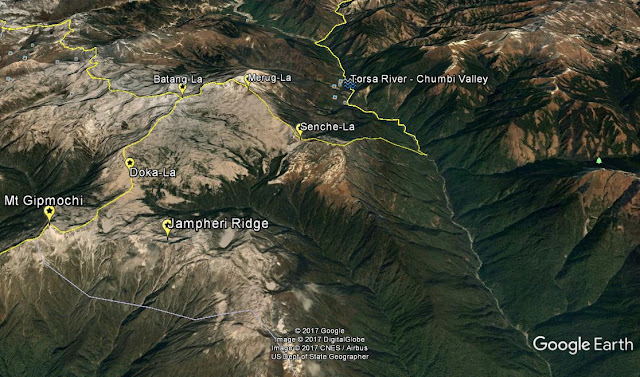Doklam stand-off: India should clarify its position on the 1890 Convention
Summary: Britain had no authority to fix the Sikkim-Tibet-Bhutan trijunction in the 1890 Convention. Partially withdrawing from this Convention would bring clarity and consistency to India's position.
The statement made by Smt Sushma Swaraj in the Rajya Sabha, on 03 Aug 2017, on the Doklam issue, quotes from the 2012 agreement between Indian and China:
There is mutual agreement on the basis of the alignment of the India China boundary in the Sikkim sector as provided by the convention between China and Great Britain relating to Tibet and Sikkim signed in 1890.
Now, the 1890 Convention between Great Britain and China states:
The boundary of Sikkim and Tibet shall be the crest of the mountain range separating the waters flowing into the Sikkim Teesta and its affluents from the waters flowing into the Tibetan Mochu and northwards into other rivers of Tibet. The line commences at Mount Gipmochi, on the Bhutan frontier, and follows the above-mentioned water-parting to the point where it meets Nipal territory.
"Mochu" refers to the Bhutanese river Mo Chhu, which flows into the Brahmaputra. The phrase "waters flowing ... into other rivers of Tibet" may be construed to include the watershed of the Amo Chhu, which flows from Tibet, and becomes the Torsa in Bhutan and India.
This statement defines a line from the Sikkim-Tibet-Bhutan trijunction (deemed to be at Mt Gipmochi), to the Sikkim-Tibet-Nepal trijunction. The territory on one side of this line is deemed to belong to Sikkim, and that on the other side is deemed to belong to Tibet.
It is important to note that Bhutan is not a signatory to the 1890 Convention. At the time, relations between Bhutan and Britain were governed by the Treaty of Sinchula, imposed on Bhutan by the British in the aftermath of the 1864-65 Duar War. This treaty did not authorize Britain to act on Bhutan's behalf. Thus, the British were not empowered to fix the Sikkim-Tibet-Bhutan trijunction, which impinges Bhutan's territory. This is a serious flaw in the 1890 Convention. In fact, it seems that the British had a hostile attitude towards Bhutan, as shown by the reference to the Bhutanese Mo Chhu as the "Tibetan Mochu". Be that as it may, this Convention was inherited by independent India as per the Indian Independence (International Arrangement) Order notified by Secretariat of the Governor-General on 14 August, 1947.
The first step for India is to clarify to what extent it recognizes the 1890 Convention. If India accepts the convention in full, it amounts to accepting that the area where the stand-off is taking place is in Tibet, and thus in China. This would not prevent Bhutan from making its own claim to the area, since it is not a signatory to the 1890 Convention. However, it would prevent India from intervening directly. The situation is illustrated by the following example:
Suppose a nation A agrees that a piece of land L belongs to a nation B. Later, nation B and nation C have a dispute over the land L. Can nation A intervene on behalf of nation C?
Even in this scenario, there is a lot which India and Bhutan can do to protect their interests -
- Bhutan is not barred from deploying its own troops in the Doklam area. India can give assistance to the Bhutanese Army to strengthen their capabilities (albeit without directly intervening in the Doklam area).
- The Jampheri ridge is about 2 km south of the stand-off point, and overlooks the North Bengal plains in the Siliguri corridor. India considers it crucial that the Chinese not establish themselves on this ridge. Even under the maximal Chinese claim, with Mt Gipmochi as the trijunction, Bhutan has a right to be on the Jampheri ridge. On Bhutan's invitation, India can also be there. Thus, Indian and Bhutanese troops could strongly entrench themselves on the ridge, while Bhutanese troops continue to patrol the Doklam area.
- India could also help Bhutan to improve the accessibility of the Jampheri ridge. India has access to the ridge from near Mt Gipmochi. Possibly, a ropeway to the ridge could also be established, from the southern side.
A second option would be for India to state that it respects the 1890 Convention insofar as it pertains to the limits of Indian territory, but the Convention is void as regards the trijunction, since Britain had no authority to tamper with Bhutanese territory. If India takes this stand, then India would not be in the awkward position of having its troops in an area that it has recognized as part of Tibet. When combined with the undeniable Chinese violation of their status-quo agreements with Bhutan, it would put India on a surer legal footing.
To summarize, there are two legally valid options for India - (i) withdraw soldiers from Doklam, and get the Bhutanese to deploy their own troops, AND/OR (ii) state that the 1890 Convention is void as far as the location of the trijunction is concerned. Possibly, India could do both (i) and (ii).
----------------------------
Readers are welcome to leave a comment below. Feedback also welcome by email at bharatdharma7@gmail.com and on twitter @BharatDharma
----------------------------
Readers are welcome to leave a comment below. Feedback also welcome by email at bharatdharma7@gmail.com and on twitter @BharatDharma


Comments
Post a Comment